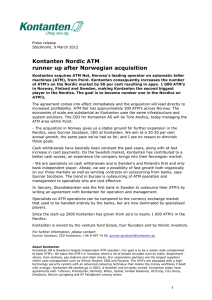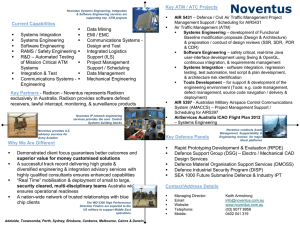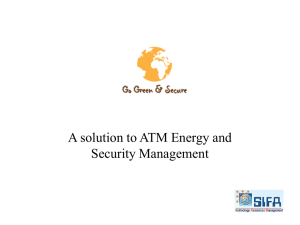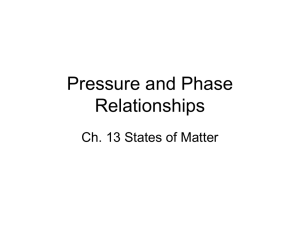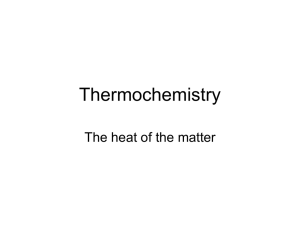ATM
advertisement
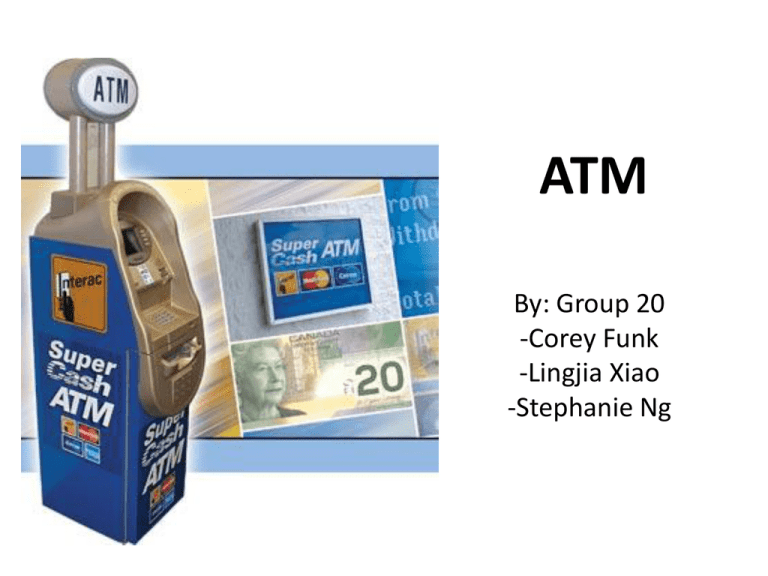
ATM By: Group 20 -Corey Funk -Lingjia Xiao -Stephanie Ng What is an ATM? • Automated Teller Machine • computerized telecommunications device that provides the clients of a financial institution with access to financial transactions in a public space without the need for a cashier, human clerk or bank teller. • Other Names: Automatic Banking Machine, Cash Machine etc. Who invented the first ATM? • Many people have tried to claim themselves as the “inventor of the ATM” • From Sweden, the United States, and the United Kingdom • Luther George Simjian • Don Wetzel • John Shepherd-Barron • James Goodfellow • John D. White • Jairus Larson Who invented the first ATM? (cont’d) • Luther George Simjian – Idea came first in late 1930 – Registered 20 patents in 1939 – Not-so-successful • Don Wetzel – American engineer – Designed Docuteller machine in 1968 – Hold USA patent to the ATM in 1973 Who invented the first ATM? (cont’d) • John Shepherd-Barron – Indian Born Scottish – Idea of 24/7 cash dispenser – First ATM in England in 1967 • James Goodfellow – Development engineer – Design accepted a machine readable encrypted card, to which he added a numerical keypad – Covered by UK Patent in 1966 Who invented the first ATM? (cont’d) • John D. White – Started work in 1968 – First ATM at Rockville Centre, LI in 1973 – “Credit Card Automatic Currency Dispenser” Patented in 1973 – Design similar to the free standing ATM nowadays • Jairus Larson – First on-line ATM in 1970’s – Able to communicate with the bank’s computer system Who invented the first ATM? Summary • Who invented the idea of an ATM? – Luther George Simjian • Who invented the ATM as we know it? – James Goodfellow in Scotland • Who invented the free standing ATM design we recognize today? – John D. White in the US For more information: http://www.atmmachine.com/atm-inventor.html Where was the first ATM installed? Where was the first ATM installed? • In 1967, John Shepherd-Barron invented and installed an ATM in a Barclays Bank in London. Don Wetzel invented an American made ATM in 1968. • In 1969 Docutel installed its Docuteller machine at New York's Chemical Bank - This is the first use of magnetically encoded plastic. How did early machines work in comparison to the banking machines we use today? Hardware Hardware (cont’d) • • • • • • • • • • • A block diagram of an ATM An ATM is typically made up of the following devices: CPU (to control the user interface and transaction devices) Magnetic and/or Chip card reader (to identify the customer) PIN Pad (similar in layout to a Touch tone or Calculator keypad), often manufactured as part of a secure enclosure. Secure cryptoprocessor, generally within a secure enclosure. Display (used by the customer for performing the transaction) Function key buttons (usually close to the display) or a Touchscreen (used to select the various aspects of the transaction) Record Printer (to provide the customer with a record of their transaction) Vault (to store the parts of the machinery requiring restricted access) Housing (for aesthetics and to attach signage to) Business owners often lease ATM terminals from ATM service providers • Two Loomis employees refilling an ATM at the Downtown Seattle REI • The vault of an ATM is within the footprint of the device itself and is where items of value are kept. Scrip cash dispensers do not incorporate a vault. • Mechanisms found inside the vault may include: • Dispensing mechanism • Deposit mechanism including a Check Processing Module and Bulk Note Acceptor • Security sensors Locks Software • A Suncorp Metway ATM running OS/2 • With the migration to commodity PC hardware, standard commercial "off-the-shelf" operating systems and programming environments can be used inside of ATMs. • Typical platforms previously used in ATM development include RMX or OS/2. • Today the vast majority of ATMs worldwide use a Microsoft OS, primarily Windows XP Professional or Windows XP Embedded Software (cont’d) • A Wincor Nixdorf ATM running Windows 2000 • Linux is also finding some reception in the ATM marketplace. Software (cont’d) • With the move to a more standardized software base, financial institutions have been increasingly interested in the ability to pick and choose the application programs that drive their equipment. • WOSA/XFS, now known as XFS ,provides a common API for accessing and manipulating the various devices of an ATM. • J/XFS is a Java implementation of the CEN XFS API. Software (cont’d) • Notable ATM software that operates on XFS platforms include Triton PRISM, Diebold Agilis EmPower, NCR APTRA Edge, Absolute Systems AbsoluteINTERACT, KAL Kalignite, Phoenix Interactive VISTAatm, and so on • With the move of ATMs to industry-standard computing environments, concern has risen about the integrity of the ATM's software stack Security Features • Types of attacks: – Physical attacks – Attacks on consumers Security Features (cont’d) • Physical Attacks – Ram raids: • • • • Break into a property and break open or steal an ATM Most common physical attack on ATMs Bolting down portable machines can deter or delay thieves Alarms developed that trip when machine is moved or tilted – Plofkraak method (using a controlled explosion) • Originated in the Netherlands, Literally means “Blast breaking” • Happens most often in Europe, but has happened in North America • Involves filling the safe with an explosive gas, igniting the gas and blowing the doors off • Newer machines have ventilation system for the safe • Prevents any dangerous gas buildup Security Features (cont’d) – Attaching false parts • Cash dispensing slot can be replaced with one that catches the cash • The customer doesn’t receive the cash • Thief comes by later, and takes the false slot containing customer’s cash • Design the slot so that a false slot would be obvious -False slot fixed to the original card slot. Contains additional card reader to copy your card information and duplicate your card. Security Features (cont’d) • Attacks on consumers – Forced withdrawals • Customer is threatened, forcing them to withdraw money for a thief • Cameras can capture the event happening • Emergency PIN can be activated in such an event, which is usually the customer’s PIN reverse – Identity theft • • • • • Skimming devices attached to machine Captures PIN and card data Easily blends in with the rest of the machine Consists of a card reader and a small camera Sensors are installed in ATMs near the card slot to detect unauthorized readers Security Features (cont’d) • Attacks on consumers (cont’d) – Identity theft (cont’d) • Shoulder surfing • Involves a thief watching a customer enter their personal information, and stealing their card later • Mirrors are installed on some ATMs so the customer can see behind them • Cameras are often installed near or inside ATMs, to use as evidence against cases of Identity theft Security Features (cont’d) • Other security features – Encrypted transmissions to banks • DES or TripleDES encryption – Video surveillance • Cameras near and inside ATM – Consumer awareness • Teach consumers how to look for signs of and prevent identity theft Effects of Online Banking • Online banking has become very common • Easy to set up and use • May decrease some ATM use for bill paying and deposits • Home computers can’t dispense cash • ATMs are often found near retailers or other convenient places Questions?
